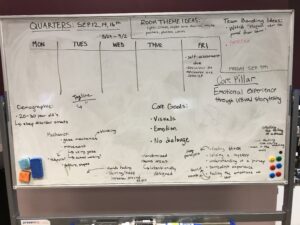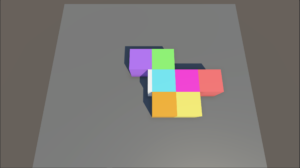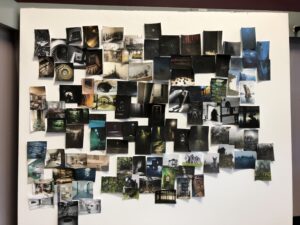Hi, we’re team Genscape! Last semester, the four of us came together to pitch the idea of developing a virtual reality project that explored the concept of lucid dreaming. The key pillar of our pitch is that we wanted the experience to be visual art focused, and to be emotional without relying on a traditional narrative. On the technology side, we wanted to explore how procedural generation could help create dream worlds that were unique and ever-changing. Our pitch was selected to move forward, and this week we got started taking it into production.
We kicked off our project this week by meeting with our faculty advisor, Ricardo Washington. Ricardo stressed that, as a pitch project, 1/4s would be a big deadline for us. Since we did at least some of our pre-production over the course of developing our pitch, the faculty would want to see that we were able to capitalize on that by moving into production quickly. So, we set a target of having an early playable demo by the day of our 1/4s presentations.

Coming out of the pitch process our team had a fairly clear shared idea of what we wanted to make; however, we still had a few key decisions to make before we could fully move into production. What was our demographic? What was our specific setting, and what were the main mechanics of the game? How exactly were we going to use procedural generation to make the experience stronger? Answering these questions became the focus of our first week.


A team meeting on Tuesday provided the answers to many of these questions. We determined that we wanted to target our experience at 20-to-30-year-olds. We strengthened our core design goals by making them more specific, such as replacing the idea of “no narrative” with “no dialogue.” We discussed specific mechanics that could strengthen our dream world, such as making the world feel reactive by modeling the guest’s gaze as an invisible object in the game world, allowing us to trigger various effects depending on where our guest looked. We also determined the scope of procedural generation we wanted to use—our dream worlds would be made of discrete sections that could be procedurally rearranged, but all of the content within each section would be handcrafted, to give us the right amount of authored control over our guests’ experiences. By the end of the week, we had prepared basic demos of both the gaze mechanic and a simple version of procedural level generation.

The next thing we needed to decide was what kind of setting we wanted to explore in our game. We knew from our pitch that we wanted to create 3 dream worlds, each themed around a particular emotion: fear, melancholy, or regret. We decided to focus on fear for our first environment, but that was still a broad topic that could take many visual forms. To get to a more specific answer, we developed a survey and sent it out to members of our target demographic. In it, we asked our participants about which colors, sounds, locations, and general concepts they associated with fear. As we got responses back, we found imagery that matched the things that were repeatedly mentioned. We used that imagery to create a moodboard that will guide the visual development of our fear-based setting. We also used this and other visual research to begin the development of our team poster and other branding.
We checked back in with Ricardo at the end of the week to inform him of our progress. He approved both of our work so far, and of the plan we had developed for approaching our 1/4s deadline and beyond. He also encouraged us to push further into the ideas we had begun exploring, by going wide and ambitious in the early weeks of the project before narrowing down to our final product. Our work this week has set us up very nicely to do just that moving into Week 2.
